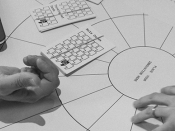Por Konstantina Kilteni (Radboud University; Karolinska Institutet).
How do we distinguish self-touch sensations (e.g. feel our hand caressing our leg) from touches of external causes (e.g. feel the touch of an insect on our leg) to generate the appropriate behaviour? This classification might seem trivial; however, it is a demanding task for the brain given the massive amount of somatosensory information that needs to be processed at any given moment. Dominant motor control theories propose that the brain uses efferent information to predict the somatosensory consequences of our actions and attenuate the associated responses (somatosensory attenuation), thereby increasing the salience of externally generated touches. In this talk, I will provide an overview of our work on somatosensory attenuation, focusing on when these predictive proceses are engaged and how they are implemented in the human brain.
Bio: Konstantina studied Electrical and Computer Engineering at the National Technical University of Athens (Greece), she did her PhD in Clinical Psychology and Psychobiology at the University of Barcelona (Spain) and her postdoc at the Department of Neuroscience at Karolinska Institute (Sweden). In January 2020 she was promoted to assistant professor funded by a career development grant from the Karolinska Institutet. In May 2020 she set up her own independent group at the Department of Neuroscience as principal investigator.
Why can’t you tickle yourself? Konstantina’s research combines computational motor control theory, force perception behavioural experiments, and state-of-the-art neuroimaging methods to address how the human brain distinguishes between self-generated and externally-generated touch.
Transmissão via Zoom.
















